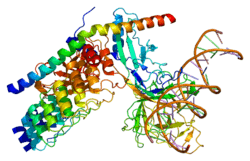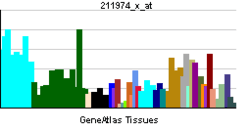RBPJ
Recombining binding protein suppressor of hairless is a protein that in humans is encoded by the RBPJ gene.[1][2][3]
RBPJ[4] also known as CBF1, is the human homolog for the Drosophila gene Suppressor of Hairless. Its promoter region is classically used to demonstrate Notch1 signaling.[5]
Interactions
RBPJ has been shown to interact with:
References
- ↑ Amakawa R, Jing W, Ozawa K, Matsunami N, Hamaguchi Y, Matsuda F, Kawaichi M, Honjo T (October 1993). "Human Jk recombination signal binding protein gene (IGKJRB): comparison with its mouse homologue". Genomics 17 (2): 306–15. doi:10.1006/geno.1993.1326. PMID 8406481.
- ↑ Tang X, Saito-Ohara F, Song J, Koga C, Ugai H, Murakami H, Ikeuchi T, Yokoyama KK (November 1997). "Assignment of the human gene for KBF2/RBP-Jk to chromosome 9p12-13 and 9q13 by fluorescence in situ hybridization". Jpn J Hum Genet 42 (2): 337–41. doi:10.1007/BF02766956. PMID 9290259.
- ↑ "Entrez Gene: RBPJ recombination signal binding protein for immunoglobulin kappa J region".
- ↑ "Human Genome Organization: RBPJ Report".
- ↑ Hsieh JJ, Henkel T, Salmon P, Robey E, Peterson MG, Hayward SD (1996). "Truncated mammalian Notch1 activates CBF1/RBPJk-repressed genes by a mechanism resembling that of Epstein-Barr virus EBNA2.". Molecular and Cellular Biology 16 (3): 952–959. PMC 231077. PMID 8622698.
- ↑ Nam Y, Weng AP, Aster JC, Blacklow SC (June 2003). "Structural requirements for assembly of the CSL.intracellular Notch1.Mastermind-like 1 transcriptional activation complex". J. Biol. Chem. 278 (23): 21232–9. doi:10.1074/jbc.M301567200. PMID 12644465.
- ↑ Aster JC, Robertson ES, Hasserjian RP, Turner JR, Kieff E, Sklar J (April 1997). "Oncogenic forms of NOTCH1 lacking either the primary binding site for RBP-Jkappa or nuclear localization sequences retain the ability to associate with RBP-Jkappa and activate transcription". J. Biol. Chem. 272 (17): 11336–43. doi:10.1074/jbc.272.17.11336. PMID 9111040.
- ↑ Beatus P, Lundkvist J, Oberg C, Pedersen K, Lendahl U (June 2001). "The origin of the ankyrin repeat region in Notch intracellular domains is critical for regulation of HES promoter activity". Mech. Dev. 104 (1-2): 3–20. doi:10.1016/s0925-4773(01)00373-2. PMID 11404076.
- ↑ Zhou S, Hayward SD (September 2001). "Nuclear localization of CBF1 is regulated by interactions with the SMRT corepressor complex". Mol. Cell. Biol. 21 (18): 6222–32. doi:10.1128/mcb.21.18.6222-6232.2001. PMC 87339. PMID 11509665.
- ↑ Kurooka H, Honjo T (June 2000). "Functional interaction between the mouse notch1 intracellular region and histone acetyltransferases PCAF and GCN5". J. Biol. Chem. 275 (22): 17211–20. doi:10.1074/jbc.M000909200. PMID 10747963.
- ↑ 11.0 11.1 Zhou S, Fujimuro M, Hsieh JJ, Chen L, Hayward SD (February 2000). "A role for SKIP in EBNA2 activation of CBF1-repressed promoters". J. Virol. 74 (4): 1939–47. doi:10.1128/jvi.74.4.1939-1947.2000. PMC 111672. PMID 10644367.
- ↑ Hsieh JJ, Zhou S, Chen L, Young DB, Hayward SD (January 1999). "CIR, a corepressor linking the DNA binding factor CBF1 to the histone deacetylase complex". Proc. Natl. Acad. Sci. U.S.A. 96 (1): 23–8. doi:10.1073/pnas.96.1.23. PMC 15086. PMID 9874765.
- ↑ Zhou S, Fujimuro M, Hsieh JJ, Chen L, Miyamoto A, Weinmaster G, Hayward SD (April 2000). "SKIP, a CBF1-associated protein, interacts with the ankyrin repeat domain of NotchIC To facilitate NotchIC function". Mol. Cell. Biol. 20 (7): 2400–10. doi:10.1128/mcb.20.7.2400-2410.2000. PMC 85419. PMID 10713164.
Further reading
- Oka C, Kawaichi M (1995). "V(D)J recombination of immunoglobulin genes". Adv. Biophys. 31: 163–80. doi:10.1016/0065-227X(95)99390-B. PMID 7625272.
- Matsunami N, Hamaguchi Y, Yamamoto Y, Kuze K, Kangawa K, Matsuo H, Kawaichi M, Honjo T (1990). "A protein binding to the J kappa recombination sequence of immunoglobulin genes contains a sequence related to the integrase motif". Nature 342 (6252): 934–7. doi:10.1038/342934a0. PMID 2556644.
- Tong X, Drapkin R, Yalamanchili R, Mosialos G, Kieff E (1995). "The Epstein-Barr virus nuclear protein 2 acidic domain forms a complex with a novel cellular coactivator that can interact with TFIIE". Mol. Cell. Biol. 15 (9): 4735–44. PMC 230717. PMID 7651391.
- Zhao B, Marshall DR, Sample CE (1996). "A conserved domain of the Epstein-Barr virus nuclear antigens 3A and 3C binds to a discrete domain of Jkappa". J. Virol. 70 (7): 4228–36. PMC 190353. PMID 8676443.
- Tamura K, Taniguchi Y, Minoguchi S, Sakai T, Tun T, Furukawa T, Honjo T (1997). "Physical interaction between a novel domain of the receptor Notch and the transcription factor RBP-J kappa/Su(H)". Curr. Biol. 5 (12): 1416–23. doi:10.1016/S0960-9822(95)00279-X. PMID 8749394.
- Gress TM, Müller-Pillasch F, Geng M, Zimmerhackl F, Zehetner G, Friess H, Büchler M, Adler G, Lehrach H (1996). "A pancreatic cancer-specific expression profile". Oncogene 13 (8): 1819–30. PMID 8895530.
- Hsieh JJ, Nofziger DE, Weinmaster G, Hayward SD (1997). "Epstein-Barr virus immortalization: Notch2 interacts with CBF1 and blocks differentiation". J. Virol. 71 (3): 1938–45. PMC 191274. PMID 9032325.
- Aster JC, Robertson ES, Hasserjian RP, Turner JR, Kieff E, Sklar J (1997). "Oncogenic forms of NOTCH1 lacking either the primary binding site for RBP-Jkappa or nuclear localization sequences retain the ability to associate with RBP-Jkappa and activate transcription". J. Biol. Chem. 272 (17): 11336–43. doi:10.1074/jbc.272.17.11336. PMID 9111040.
- Kao HY, Ordentlich P, Koyano-Nakagawa N, Tang Z, Downes M, Kintner CR, Evans RM, Kadesch T (1998). "A histone deacetylase corepressor complex regulates the Notch signal transduction pathway". Genes Dev. 12 (15): 2269–77. doi:10.1101/gad.12.15.2269. PMC 317043. PMID 9694793.
- Hsieh JJ, Zhou S, Chen L, Young DB, Hayward SD (1999). "CIR, a corepressor linking the DNA binding factor CBF1 to the histone deacetylase complex". Proc. Natl. Acad. Sci. U.S.A. 96 (1): 23–8. doi:10.1073/pnas.96.1.23. PMC 15086. PMID 9874765.
- Scanlan MJ, Gordan JD, Williamson B, Stockert E, Bander NH, Jongeneel V, Gure AO, Jäger D, Jäger E, Knuth A, Chen YT, Old LJ (1999). "Antigens recognized by autologous antibody in patients with renal-cell carcinoma". Int. J. Cancer 83 (4): 456–64. doi:10.1002/(SICI)1097-0215(19991112)83:4<456::AID-IJC4>3.0.CO;2-5. PMID 10508479.
- Callahan J, Aster J, Sklar J, Kieff E, Robertson ES (2000). "Intracellular forms of human NOTCH1 interact at distinctly different levels with RBP-jkappa in human B and T cells". Leukemia 14 (1): 84–92. doi:10.1038/sj.leu.2401630. PMID 10637481.
- Smith PR, de Jesus O, Turner D, Hollyoake M, Karstegl CE, Griffin BE, Karran L, Wang Y, Hayward SD, Farrell PJ (2000). "Structure and coding content of CST (BART) family RNAs of Epstein-Barr virus". J. Virol. 74 (7): 3082–92. doi:10.1128/JVI.74.7.3082-3092.2000. PMC 111807. PMID 10708423.
- Zhou S, Fujimuro M, Hsieh JJ, Chen L, Miyamoto A, Weinmaster G, Hayward SD (2000). "SKIP, a CBF1-associated protein, interacts with the ankyrin repeat domain of NotchIC To facilitate NotchIC function". Mol. Cell. Biol. 20 (7): 2400–10. doi:10.1128/MCB.20.7.2400-2410.2000. PMC 85419. PMID 10713164.
- Kurooka H, Honjo T (2000). "Functional interaction between the mouse notch1 intracellular region and histone acetyltransferases PCAF and GCN5". J. Biol. Chem. 275 (22): 17211–20. doi:10.1074/jbc.M000909200. PMID 10747963.
- Beatus P, Lundkvist J, Oberg C, Pedersen K, Lendahl U (2001). "The origin of the ankyrin repeat region in Notch intracellular domains is critical for regulation of HES promoter activity". Mech. Dev. 104 (1–2): 3–20. doi:10.1016/S0925-4773(01)00373-2. PMID 11404076.
- Zhou S, Hayward SD (2001). "Nuclear localization of CBF1 is regulated by interactions with the SMRT corepressor complex". Mol. Cell. Biol. 21 (18): 6222–32. doi:10.1128/MCB.21.18.6222-6232.2001. PMC 87339. PMID 11509665.
External links
- RBPJ protein, human at the US National Library of Medicine Medical Subject Headings (MeSH)
| |||||||||
| ||||||||||||||||||||||||||||||||||||||||||||||||||||||||||||||||||||||||||||||||||||||||||||||||||||||||||||||||||||||||||||||||||||||||||||||||||||||||||||||||||||||||||||||||||||||||||||||||||||||||||||||
This article incorporates text from the United States National Library of Medicine, which is in the public domain.


